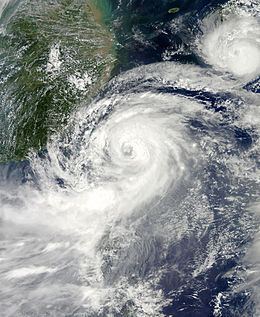Formed July 26, 2012 Fatalities 82 total | Dissipated August 5, 2012 | |
 | ||
Highest winds 10-minute sustained: 130 km/h (80 mph)1-minute sustained: 165 km/h (105 mph) Lowest pressure 960 hPa (mbar); 28.35 inHg Damage $161 million (2012 USD) Date 26 July 2012 – 5 August 2012 Category Category 2 Tropical Cyclone (BOM) Similar Typhoon Damrey, Typhoon Haikui, Typhoon Tembin, Typhoon Kai‑tak, Typhoon Soulik | ||
Typhoon Saola, known in the Philippines as Typhoon Gener, was a strong tropical cyclone affecting the Philippines, Taiwan and China. It was the ninth named storm and the fourth typhoon of the 2012 Pacific typhoon season. Saola is the name of a rare mammal found in Vietnam.
Contents
Meteorological history
On July 26, the Japan Meteorological Agency (JMA) reported that a tropical depression had developed within an area of strong vertical windshear in the monsoon trough about 1,000 kilometres (620 mi) to the southeast of Manila in the Philippines. During that day the shear relaxed before during the next day, the Joint Typhoon Warning Center (JTWC) issued a Tropical Cyclone Formation Alert on the system.
Early on July 28, the JTWC upgraded the system to a tropical depression, whilst the JMA upgraded it to a tropical storm and named it Saola. Soon, the Philippine Atmospheric, Geophysical and Astronomical Services Administration (PAGASA) upgraded the system to a tropical depression and named it Gener. Later that day, the JTWC upgraded Saola to a tropical storm. Early on July 29, the JMA upgraded Saola to a severe tropical storm. On July 30, the JTWC upgraded Saola to a category 1 typhoon, as it started to develop an eye-like feature, but soon downgraded it to a tropical storm late on the same day. On July 31, the JTWC upgraded Saola to a category 1 typhoon again. Late on the same day, the JMA upgraded Saola to a typhoon, and the JTWC soon upgraded it to a category 2 typhoon early on the next day. The Central Weather Bureau (CWB) reported that Typhoon Saola made landfall over Xiulin, Hualien in Taiwan at 19:20 UTC on August 1 (03:20 TST on August 2). However, Saola later moved counterclockwise and arrived the ocean soon, whilst the JMA downgraded it to a severe tropical storm early on August 2 due to strong land interaction. At 06Z on the same day, Saola passed over Cape San Diego, the easternmost point of Taiwan. Late on August 2, the JMA downgraded Saola to a tropical storm, before it made landfall over Fuding in Fujian, China at 22:50 UTC (06:50 CST on August 3). On August 3, the JMA downgraded Saola to a tropical depression, after the JTWC issued a final warning on the system. The system continued to weaken into a weak low pressure area over Jiangxi, China on August 4. The weak, remnant low later drifted south west to the Gulf of Tokin, and regenerated slightly on August 7.
Philippines
Saola caused widespread rains in the Philippines due to the enhancement of the southwest monsoon. On July 29, domestic and international flights throughout the country were delayed and cancelled. Small fishing crafts were advised to not engage in the water as a gale warning was issued by PAGASA. The NDRRMC alerted their agency as the storm is expected to bring heavy rains. Seaports were also advised to cancel their trips. Flooding is imminent as different dams are expected to reach its critical level and possibly release huge millimeters of water. About three roads in northern Luzon were impassable due to floods and landslides. About sixty families in Rodriguez, Rizal were evacuated due to severe flooding in the area. Early on July 30, classes were suspended from pre-school to tertiary level as strong winds and severe rainfall were recorded throughout Metro Manila and nearby provinces.
Initial reports spoke of around a dozen confirmed casualties, yet early on 3 August Philippine authorities revised the death toll in the country to 37, with at least 519,000 people affected. More than 17,500 were staying in evacuation centers. As of August 6, 51 fatalities were confirmed in the Philippines with six others reported missing. Damage from the storm amounted to about ₱404 million (US$9.6 million), half of which was due to agricultural losses.
Taiwan
As the storm made landfall in Taiwan, almost the entire island suspended services as high winds and rains triggered flooding in several locations. Almost 70 inches fell in some areas, ranking Saola within the top 5 wettest cyclones to ever hit the island. Authorities ordered schools and business to shut, with the exception of few major factories. Financial markets were also closed, and would remain until 3 August. Taiwanese Army soldiers rescued more than 1,000 people from remote mountainous villages in the north and east. Two passenger boarding bridges collapsed at Taoyuan International Airport, which serves Taipei, slightly damaging a China Airlines aircraft and forcing the company to scrap the flight. More than 200 international and domestic flight were reportedly cancelled because of the storm.
At least six people were killed and two were missing in Taiwan as of 2 August, in addition to 16 injured. Agricultural losses across the island were estimated at NT$812.51 million (US$27.14 million).
China
In Hubei Province, flooding set off by more than 400 mm (16 in) of rain produced by Typhoon Saola killed 25 people and left 9 others missing. A total of 9,708 homes were destroyed and 36,726 more were damaged. Over 135,000 people were displaced by the floods and left in need of assistance across the province. Total economic losses in the province reached US$124 million.
